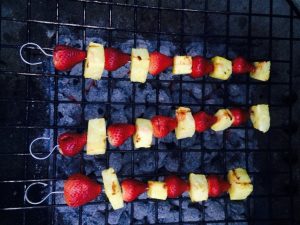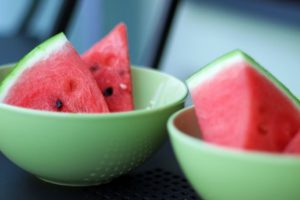by Heidi Copeland | Jun 12, 2016
What’s in season now? Although summer doesn’t officially start for a few more weeks farmers have been busy producing seasonal, summer fruits and vegetables. The seasonal vegetable guide for North Florida Produce has an abundance! Not only are basil and beans plentiful, so are blackberries, blueberries and mulberries, corn, cucumbers, eggplant, garlic, melons, okra, peas (southern) peppers, summer squash, and tomatoes. (in the southern part of Florida avocado, guava, lychee, mango, papaya, and passion fruit are showing up)
Fruits and vegetables are loaded with great vitamins and minerals! And eating at least 3-5 servings a day of fruits and vegetables is truly considered the key to good health. Folks who eat a wide variety of colors – both fruits and vegetables, as part of an overall healthy diet, are likely to have a reduced risk of some chronic diseases. Both fruits and vegetables provide nutrients vital for health and maintenance of your body.
Eating fruits and vegetables is easy to do!
Have you ever tried using the United States Department of Agriculture What’s Cooking? USDA Mixing Bowl recipe finder? Using this website, I simply checked the box that I’d like to focus on, eating more fruit and vegetables then added the ingredient zucchini to the recipe search box. http://whatscooking.fns.usda.gov/ 
Sixty recipes popped up! I choose the one for Squash Squares.
Squash Squares: Ingredients
4 eggs (beaten lightly)
1/4 cup oil
3 cups thinly sliced squash (use zucchini or yellow squash)
1/4 cup chopped onion
1 cup biscuit mix
1 teaspoon dried parsley (or 2 T chopped fresh parsley)
1/3 cup grated cheddar cheese
1 cup grated carrots
Directions
- Mix all ingredients thoroughly and pour into a greased 9×13″ baking dish.
2. Bake 25 minutes, or until bubbly and brown, in a 350°F oven.
3. Serve in squares while warm.
Notes
- To freeze – Cool, and cut into squares. Freeze squares on a cookie sheet. When they are frozen, put into freezer bags. When ready to use, take out of the freezer bag, place in microwaveable covered container. Reheat in microwave at medium setting.
- Try 8 egg whites in place of whole egg for less cholesterol and fat.
- Add other thinly chopped fresh veggies into the mix – green or red sweet peppers, spinach, broccoli.
I’ve tried this recipe using both yellow squash and zucchini with equally tasty results. I especially appreciated the suggestions on the recipe to personalize by adding your own twist. Like it spicy? Add a jalapeno! Want to add some pizzazz? Add some diced red pepper for color. Want to eat it later? Just freeze and eat or reheat and eat! Don’t have zucchini on hand? Substitute other thinly chopped fresh veggies. I have even substituted the biscuit mix with a corn bread mix for yet another spin.
Fruits and vegetables are nutritious and delicious. Try adding some Florida fresh, seasonal fruits and vegetables to your meals!
by jbreslawski | Jun 11, 2016
 In Florida, we are so lucky to have access to beautiful beaches and weather. There are an infinite number of outdoor activities to do. This past week I tried a new one for me, SUP (Stand Up Paddle boarding). I fell a few times, but finally found my balance and had a blast all day long. Things changed though when the fun was over and I realized that I forgot to wear a hat and had a blistering burn on my scalp. According to the Center for disease control the sun can burn unprotected skin in as little as 15 minutes. In order to protect yourself from the sun be sure to apply and reapply sunscreen (at least SPF 15) regularly, stay in the shade, wear a hat and UV protective sunglasses, when possible protective clothing such as long sleeved shirts and pants, and limit time outdoors in peak sun hours of 10am-4pm.
In Florida, we are so lucky to have access to beautiful beaches and weather. There are an infinite number of outdoor activities to do. This past week I tried a new one for me, SUP (Stand Up Paddle boarding). I fell a few times, but finally found my balance and had a blast all day long. Things changed though when the fun was over and I realized that I forgot to wear a hat and had a blistering burn on my scalp. According to the Center for disease control the sun can burn unprotected skin in as little as 15 minutes. In order to protect yourself from the sun be sure to apply and reapply sunscreen (at least SPF 15) regularly, stay in the shade, wear a hat and UV protective sunglasses, when possible protective clothing such as long sleeved shirts and pants, and limit time outdoors in peak sun hours of 10am-4pm.
Oh, so you don’t need to because you tan? Well think again. esides leaving you with an awful burn, blisters and flakey skin, sitting out in the sun can cause lines and wrinkles, sun-spots, and increase your chance of skin cancer. The American Cancer Society is estimating 6,200 new cases of skin cancer, this year, in Florida alone. Most of these cases can be linked to too much sun exposure. Regular sun protection can reduce the risk of developing skin cancer; regular dermatologist skin checks and self-exams can help identify cases early. The Skin Cancer Foundation, recommends keeping watch for individual moles that are misshapen, have uneven borders, a variety of colors, a diameter of over ¼”, or have changed in any of these features. This summer have fun, live in the moment, try something new, but don’t forget your SPF.
by Marjorie Moore | Jun 1, 2016
 Did you know that the majority of people grill on July 4th (82%), followed by Birthdays (72%), Labor Day (70%), Memorial Day (62%) and the Super Bowl (30%)? Grilling is an all-time favorite for many households and now that the weather is warming, more families are using their grills to prepare family meals.
Did you know that the majority of people grill on July 4th (82%), followed by Birthdays (72%), Labor Day (70%), Memorial Day (62%) and the Super Bowl (30%)? Grilling is an all-time favorite for many households and now that the weather is warming, more families are using their grills to prepare family meals.
Enjoy grilling this season but be sure to be safe to avoid accidents. According to the National Fire Protection Association between 2007-2011, gas grills were involved in an annual average of 7,200 home fires, while charcoal or other solid-fueled grills were responsible for an annual average of 1,400 home fires.
Whether you have a charcoal, gas or in-door grill, become the grill master in your house by carefully reading the manufacturer’s operating and maintenance instructions for your family’s grill. Follow these important tips to help you and your family use your grill safely.
- Regularly remove grease or fat buildup from the racks/grates to reduce chances of having a fire. Thoroughly clean your grill at least once a year so it will last longer.
- For charcoal grills, look at the new safety label on the charcoal bags. Charcoal is hard to ignite so people are often tempted to use ready-to-light charcoal or charcoal fluid. These products seem to make lighting charcoal easier, but they will introduce a lot of chemicals and sometimes leave a chemical taste on the food. Always, follow the manufacturer’s instructions and never use lighter fluid after the fire is started.
- Remember to only use your gas and charcoal grills outside.
- Place your gas grill at least 10 feet away from your house or any building. Never grill in the garage, breezeway, carport, porch, or under a surface that can catch fire.
- Keep a fire extinguisher accessible in the event of a fire.
- Always keep food safety in mind when grilling and use different dishes and utensils for raw meat and cooked meat. By putting cooked food on plates that held raw meat, you are cross-contaminating the food. Any bacteria present in the raw meat could be reintroduced to the cooked food.
- Cold food should be kept cold until ready to grill – never leave raw meat, poultry, or any perishable food out at room temperature for more than two hours.
- Don’t forget to use a thermometer, especially when cooking meat, poultry and fish. Raw meat can contain harmful bacteria and other pathogens, which can cause food poisoning if ingested. A meat thermometer is an especially important tool and will help guard against food poisoning. The color of meat and poultry is not a good indicator of safety.
For more information, check out our grilling factsheet. http://bay.ifas.ufl.edu/fnc/files/2011/09/Grilling-safety.pdf
by Amy Mullins, PhD, RDN | May 30, 2016
It’s hard to believe that summer is almost here and the kids are out of school! Often times, when kids (and parents too) get away from their normal routine, poor eating and snacking habits creep in. It’s important for kids (and parents) to have a variety of go-to snacks that are tasty, healthy, and easy to prepare!
Put some thought into which snacks make the best choices, and get input from the kids. Children and teenagers are more likely to eat what you buy (and be excited about it!), if they help in the process.
 1.) PLAN: Sit down together and make a list of snack-type foods they might like, and can easily prepare themselves.
1.) PLAN: Sit down together and make a list of snack-type foods they might like, and can easily prepare themselves.
2.) LIST: Make a list of the foods you’ll need to pick up at the grocery store.
3.) SHOP: Take the kids with you shopping… let them help fill the cart with the foods you’ve agreed on.
4.) PREPARE: Allow the kids to help wash, cut, portion, and prepare snacks. This will give them more confidence in the kitchen… now and as a future adult.
Stumped on where to get started? Your best bet is to stay away from processed, pre-packaged snack foods, and sugary drinks. These are typically high in unhealthy fats, oils, and sugar, and lack the vitamins, minerals, and fiber fresh and frozen whole foods have.
Try these super easy and healthy snacks:
- Layer vanilla yogurt and mandarin oranges or blueberries in a tall glass. Top with a sprinkle of granola to make a “parfait”.
- Put cubes of low-fat cheese and grapes on pretzel sticks to make “snack-kabobs”.
- Top a banana with low-fat vanilla and strawberry frozen yogurt and sprinkle with your favorite whole-grain cereal for a healthy “banana-split”.
- Use whole grain (flour or corn) tortillas and top with tomato sauce, cut veggies and shredded cheese. Eat it flat (like a pizza) or roll it up (like a wrap).
Keep your children, and yourself, on track this summer by remembering these main messages from ChooseMyPlate and The Dietary Guidelines:
- Make half your plate fruits and vegetables.
- Focus on whole fruits.
- Vary your veggies.
- Make half your grains whole grains.
- Move to low-fat and fat-free milk or yogurt.
- Vary your protein routine.
- Drink and eat less sodium, saturated fat, and added sugars.
Everything you eat and drink over time matters. The right mix can help you be healthier now and in the future. Start with small changes to make healthier choices you can enjoy. Find your healthy eating style and maintain it for a lifetime.
Find more great ideas with additional resources from MyPlate Snack Tips for Parents
and The Academy of Nutrition and Dietetics 25 Healthy Snacks for Kids.
by sbouie | May 30, 2016
 Tax season is a very difficult time of year for many people. It is a time when good record keeping is vital. The preparation fee is expensive for many families. Some use computer software to avoid fees. However, in doing so they may overlook some tax deductions.
Tax season is a very difficult time of year for many people. It is a time when good record keeping is vital. The preparation fee is expensive for many families. Some use computer software to avoid fees. However, in doing so they may overlook some tax deductions.
Free tax preparation has always been offered at the Jefferson County Extension office in Monticello, FL. This year the Tallahassee United Way Volunteer Income Tax Assistance (VITA) personnel partnered with the UF/IFAS Jefferson County Extension Office, where they prepared free taxes at the Jefferson County R.J. Bailer Public Library. Appointments were reserved through the library.
A total of 312 Jefferson County residents were helped. The United Way estimated a total of $85,176 were saved in tax preparation fees. Providing these free services to the Jefferson County citizens was a great benefit. For more information, contact UF/IFAS Extension, Jefferson County http://jefferson.ifas.ufl.edu
The UF/IFAS Leon and Madison County Extension Offices also provided VITA for their citizens. They use the traditional Skye Program in collaboration with United Way.

by sbouie | May 19, 2016

Family game night promotes bonding.
Photo credit: commons.wikimedia.org
Warmer weather is here and it is time to plan some fun activities with the family. This is also the time of year when many city organizations have prepared outstanding festivals. Most festivals have something for everyone in the family.
It is always important to socialize as a family. This increases family bonding. Time together, whether outdoors or inside, is vital. There are numerous ways to bond with your family, such as:
- Eating meals together
- Attending children’s extra-curricular activities together
- Reading together
- Going to the library as a family
- Volunteering together
- Family movie night
- Family game night and many more
There are many benefits to planning and having family bonding time. These include:
*Educational Benefits
- Increased focus on homework and reading for pleasure (Eisenberg, Olson, Neumark-Sztainer, Story, & Bearinger, 2004)
- Improved school performance (Hamilton & Wilson, 2009)
- Greater development of language skills (Snow & Beals, 2006)
- Increased and more sophisticated level of vocabulary (Snow & Beals, 2006)
Health Benefits
- Improved development of healthy eating patterns (Hamilton & Wilson, 2009)
- Higher intake of several essential nutrients (Croll, Hannan, Neumark-Sztainer, Perry, & Story, 2003)
- Decreased likelihood of having eating disorders (Ackard & Neumark-Sztainer, 2001)
- Decreased likelihood of being overweight (Fulkerson, Kubik, Story, Lytle, & Arcan, 2009)
- Less likely to develop depressive symptoms (Fulkerson et al., 2009)
Social and Behavioral Benefits
- Less likely to be involved with cigarette, alcohol, and marijuana use (Eisenberg et al.,2004)
- Increased sense of family connectedness, communication, and functioning (Hamilton &Wilson, 2009)
- Increased likelihood of resisting negative peer pressure (Fulkerson et al., 2006)
- More likely to experience positive identity assets (Fulkerson et al., 2006)
- Less likely to attempt suicide (Fulkerson et al., 2006)
- Less likely to engage in sexual intercourse (Fulkerson et al., 2006)
Overall Benefits for the Family
- Regular and consistent family time
- Reduction of anxiety and depression in children
- Increased feelings of togetherness, coherence, and solidarity
- Increased emotional and social bonding
- Shared nutrition
- Relaxing, talking, and laughing as a family unit
Family bonding sets the foundation for a strong family. Family bonding gives your children stories for their present and later years. Enjoy your family time!
*”Benefits of Family Meals”, Varnessa McCray, Victor W. Harris, and Martie Gillen, This document is FCS2324, one of a series of the Department of Family, Youth and Community Sciences, Florida Cooperative Extension Service, Institute of Food and Agricultural Sciences, University of Florida. Original publication date April 2013. Visit the EDIS website at http://edis.ifas.ufl.edu.







